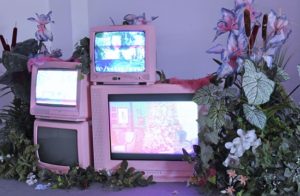Capitalism and colonialism on repeat in PAWATAMIHK

By Kelly Anne Smith
NORTH BAY—The White Water Gallery featured a Michif dreamscape for much of March with Rihkee Strapp’s PAWATAMIHK. It showed at the gallery from February 22 to March 22.
The multi-genre installation opened with an interactive performance with video, audio, and paintings.
PAWATAMIHK has been described as the aesthetic product of a culture plagued by trauma and resurgence in late colonialism.
Strapp is a multidisciplinary artist based in Baawaating territory (Sault Ste. Marie) and from Red Lake. Their work juxtaposes Norval Morrisseau’s Woodland style of painting with Vaporwave – a micro culture of the internet from the 2010s.
In Strapp’s bio from the exhibition essay, Nipissing First Nation artist Aylan Couchie writes, “In a social context, Vaporwave can be a response to capitalism, consumerism, escapism, and globalization.” Couchie concludes with a Strapp quote, “I’m a capitalist too.”
Strapp explores what it can mean for young people raised in colonized families to reconnect with their Indigenous culture, while also considering one of the many impacts of the internet.
“If you have no understanding, you might find yourself consulting grandmother Google, producing a myriad of ‘fake news’ or teachings not of your territory.”
The exhibit included a live performance opening night, which was livestreamed. Strapp explains the live performance.
“The artist performer Tejhler Leadbeater created a character that they performed all night while they went live on Instagram. If you watch the livestream you actually get to witness how Tejhler interacts with the audience at the opening,” explains Strapp. “Folks who are at the opening and not the livestream are only witnessing Tejhler running around, falling off their skateboard and asking awkward questions about how much people know about residential schools and spiritual taboos. Tejhler is performing the awkward environment that has been created for Indigenous youth between technology and tradition, and how they operate together.”

“The TV installation is a perfect example. The big TV shows one of my ancestors, Many Sitting Eagles, that was used in a popular Christmas comedy Deck the Halls and another TV show hawk from Twin Peaks,” continues Strapp. “Literally while creating the work and testing these videos in studio, I got a text from an Elder I had passed tobacco to when they visited. They texted my spirit name, which in itself is funny and appropriate for me, and it was Miskoqwan Gegek. The image of Hawk from Twin Peaks now had a HUGE spiritual meaning to me that was unintended but really brought the whole work together. The TVs are now a conversation between me and my ancestor.”
Strapp’s design brings the digital into the gallery. Neon purple, pink and blue lighting brings you into the 80s and 90s. The paintings are the artists’ perception of contemporary society and collective capitalism.
The black and white painting, Kookoosh, under black light was inspired by a post on Facebook by Elton Beardy in Thunder Bay, which Tejhler reads aloud in the performance.
Asked if the show’s opening was recorded, Strapp replied, “I didn’t record the performance as I wanted it to be only a lingering memory—like a dream. PAWATAMIHK is Michif for dream.”
PAWATAMIHK collaborators are Two Spirit and include Connor Pion, who worked on the TVs media; performance by Tejhler Leadbeater; featured beadwork by Strapp’s sister Caitlin Strapp and Jacob Day Fox. The beadwork by Fox was worn in the performance. The music was created by a Winnipeg musician, Riley Hill, also known as the Emu, a non-Indigenous/two spirit collaborator.
Strapp is a water protector with Baawating Water Protectors.
Explore Rihkee Strapp’s work on Facebook.


